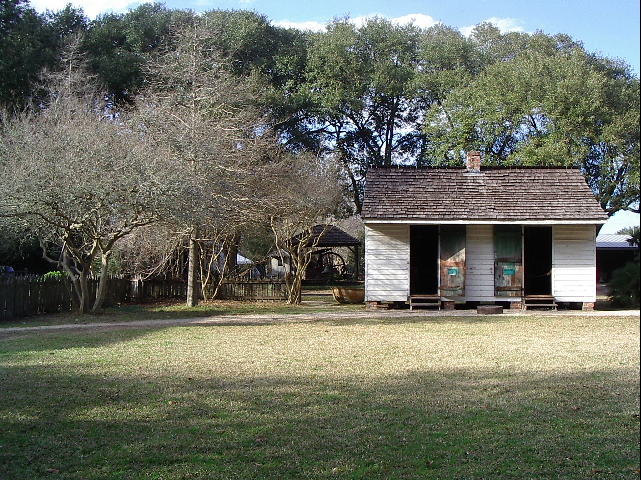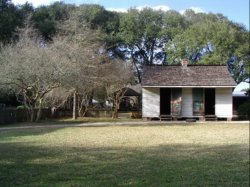Louisiana State University Rural Life Museum
The LSU Rural Life Museum is an outdoor complex of southern rural vernacular buildings located in Baton Rouge.

Photo by Shanna Riley.
A school at the LSU Rural Life Museum in 2008.
The Burden Museum and Gardens in Baton Rouge has three components: The Rural Life Museum, the LSU AgCenter Botanic Gardens, and Windrush Gardens. The complex occupies the site of a plantation, Windrush, which had been in the Burden family since the 1830s. The land was donated by landscape designer Steele Burden, his brother Pike, and his sister Ione in 1964. The land donation by the Burdens is the largest gift ever received by LSU, an estimated value of $270 million.
In 1970, Burden began relocating endangered rural vernacular buildings to the Rural Life Museum, saving more than twenty from demolition. Although the layout of the open-air complex lacks historical accuracy, it effectively interprets plantation life through a collection of authentic rural structures and illustrates various early construction techniques. Some buildings were rescued from Welham Plantation in St. James Parish (the main house was bulldozed one night in 1979 after Marathon Oil Company purchased the plantation), including four slave cabins, an overseer’s house, commissary, and smithy, all dating from the 1830s. Other structures at the site include a kitchen building (1855), a schoolhouse and a “sickhouse” (both 1830s), some privies, a small open-kettle sugarhouse and equipment, a log house (1810), a singlepen log cabin, a double-pen log barn (1847) from the Stoker homestead near Fort Jesup, and College Grove Baptist Church (1890s). Some of the transplanted buildings have been embellished, such as the small wooden church from the Welham area, which has acquired a fake cemetery, though with real iron crosses. Other structures, including the Cajun cabins, are modern replicas. The complex includes a building housing exhibits of Indian artifacts and crafts, as well as farming equipment, and serves as a research facility for LSU students of heritage conservation.
Amid the many benign artifacts displayed by the museum, a statue obtained from the city of Natchitoches has been a source of ongoing controversy. Known originally as “The Good Darky” and later as “Uncle Jack,” the statue depicts an aged African American man bowing and tipping his hat. Commissioned by prominent cotton planter and businessman Jackson Lee “Jack” Bryan in 1927, the bronze statue by Hans Schuler, Sr. (1874-1951) was installed in a city park in Natchitoches and became a local tourist attraction. Beginning in the 1960s, African Americans began to protest the statue as demeaning. It was removed by city officials, temporarily abandoned, placed in storage for several years, and then acquired in 1974 by the Rural Life Museum, where, though it is interpreted with more racial sensitivity and explained in the context of its time, it still attracts some negative reactions. Writer Maya Angelou said of the statue in 1997, “Uncle Jack is the quintessential obsequious Negro servant. . . . The droop of his shoulders bears witness not only to his years but more specifically to his own understanding of his place as a poor black in a rich white world.”
The LSU AgCenter Botanic Gardens showcases woodland and wetland trees and plant, rose gardens, and other plants and flowers. Windrush Gardens, consists of twenty-five acres of gardens planted by Steele Burden beginning in 1921. The central section has a formal layout with parterres and is surrounded by oak and pine woods and winding paths, along which are statues Burden brought back from his European travels. The gardens also include Windrush House (1850), a one-story galleried guest house, and a brick orangerie designed by A. Hays Town that features large round-headed windows and a gable roof.
Adapted from Karen Kingsley’s Buildings of Louisiana, part of the Buildings of the United States series commissioned by the Society of Architectural Historians (www.sah.org) and published by Oxford University Press.
